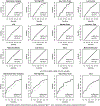Comparison of neighborhood deprivation index and food desert status as environmental predictors of early childhood obesity
- PMID: 39071797
- PMCID: PMC11274199
Comparison of neighborhood deprivation index and food desert status as environmental predictors of early childhood obesity
Abstract
Nearly 14% of American children aged 2-5 have obesity, with higher rates in children from lower-income and Black families. While evidence connects neighborhood socioeconomic environment (SEE) and obesity in adults and adolescents, little is known of this relationship in young children. We compared measures of SEE and family-level socio-demographic factors as predictors of obesity at age two.
Methods: Family-level data from the PREVAIL Cohort, a CDC-funded birth cohort in Cincinnati, Ohio, were collected prenatally from the mothers. Residential addresses were geocoded and assigned validated measures of census tract-level SEE, including USDA food desert indicators and the Deprivation Index. Family-level and ecological SEE were compared as predictors of obesity (BMIz ≥1.65) at age two in terms of proportional differences, relative risk, and model fit statistics.
Results: Residing outside of Deprivation Index High SEE neighborhoods was significantly associated with higher proportion (20.0% vs 5.9%; χ2 = 4.36, p = 0.037) and increased risk of obesity in univariable (RR = 3.4, 95%CI: 1.26-13.86) and multivariable models (RR = 3.5, 95%CI: 1.06-11.71). There were no differences in proportion or risk of obesity by USDA food desert indicators or family-level factors. Models using categorical Deprivation Index performed better than the family-level and the USDA food desert variables in terms of model fit.
Conclusion: In the PREVAIL Cohort, only category of Deprivation Index was a significant predictor of obesity in two-year-old children. Future studies are needed to evaluate the Deprivation Index as a generalizable tool to identify neighborhoods at higher risk for obesity.
Keywords: childhood obesity; food deserts; neighborhood deprivation; social determinants of health.
Figures



Similar articles
-
Neighbourhood socio-economic environment predicts adiposity and obesity risk in children under two.Pediatr Obes. 2022 Dec;17(12):e12964. doi: 10.1111/ijpo.12964. Epub 2022 Aug 17. Pediatr Obes. 2022. PMID: 36350200 Free PMC article.
-
Community-level social determinants of health and pregestational and gestational diabetes.Am J Obstet Gynecol MFM. 2024 Feb;6(2):101249. doi: 10.1016/j.ajogmf.2023.101249. Epub 2023 Dec 7. Am J Obstet Gynecol MFM. 2024. PMID: 38070680 Free PMC article.
-
Neighborhood deprivation, built environment, and overweight in adolescents in the city of Oslo.BMC Public Health. 2023 May 3;23(1):812. doi: 10.1186/s12889-023-15261-2. BMC Public Health. 2023. PMID: 37138266 Free PMC article.
-
Folic acid supplementation and malaria susceptibility and severity among people taking antifolate antimalarial drugs in endemic areas.Cochrane Database Syst Rev. 2022 Feb 1;2(2022):CD014217. doi: 10.1002/14651858.CD014217. Cochrane Database Syst Rev. 2022. PMID: 36321557 Free PMC article.
-
Screening and Interventions for Childhood Overweight [Internet].Rockville (MD): Agency for Healthcare Research and Quality (US); 2005 Jul. Rockville (MD): Agency for Healthcare Research and Quality (US); 2005 Jul. PMID: 20722132 Free Books & Documents. Review.
References
-
- Kelsey MM, Zaepfel A, Bjornstad P, Nadeau KJ. Age-related consequences of childhood obesity. Gerontology 2014;60(3):222–8. - PubMed
-
- Llewellyn A, Simmonds M, Owen CG, Woolacott N. Childhood obesity as a predictor of morbidity in adulthood: a systematic review and meta-analysis. Obes Rev 2016;17(1):56–67. - PubMed
-
- Hales C, Carroll M, Fryar C, Ogden C. Prevalence of obesity and severe obesity among adults: United States, 2017–2018. NCHS Data Brief. Hyattsville, MD: National Center for Health Statistics, 2020:360. - PubMed
Grants and funding
LinkOut - more resources
Full Text Sources
